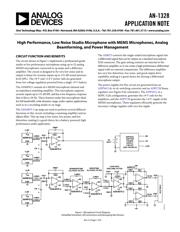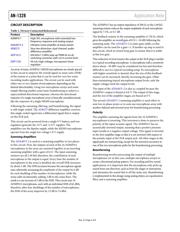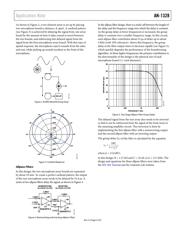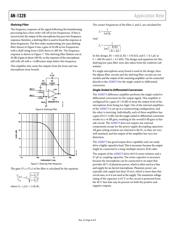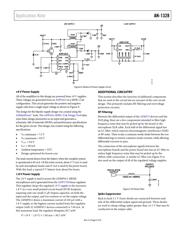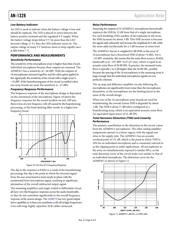Datasheet 搜索 > 放大器、缓冲器 > ADI(亚德诺) > AD8273ARZ 数据手册 > AD8273ARZ 其他数据使用手册 1/9 页
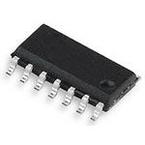
 器件3D模型
器件3D模型¥ 12.752
AD8273ARZ 其他数据使用手册 - ADI(亚德诺)
制造商:
ADI(亚德诺)
分类:
放大器、缓冲器
封装:
SOIC-14
描述:
ANALOG DEVICES AD8273ARZ 差分放大器, 2 放大器, 2 dB, 20000 kHz, -40 °C, 85 °C
Pictures:
3D模型
符号图
焊盘图
引脚图
产品图
页面导航:
典型应用电路图在P1
原理图在P1
导航目录
AD8273ARZ数据手册
Page:
of 9 Go
若手册格式错乱,请下载阅览PDF原文件

AN-1328
APPLICATION NOTE
One Technology Way • P. O. Box 9106 • Norwood, MA 02062-9106, U.S.A. • Tel: 781.329.4700 • Fax: 781.461.3113 • www.analog.com
High Performance, Low Noise Studio Microphone with MEMS Microphones, Analog
Beamforming, and Power Management
CIRCUIT FUNCTION AND BENEFITS
The circuit shown in Figure 1 implements a professional grade
studio or live performance microphone using up to 32 analog
MEMS microphones connected to op amps and a difference
amplifier. The circuit is designed to be very low noise and its
output is linear for acoustic inputs up to 131 dB sound pressure
level (SPL). The ±9 V and +1.8 V power rails are generated
from two voltage regulators powered from a single +9 V battery.
The ADMP411 consists of a MEMS microphone element and
an impedance matching amplifier. This microphone supports
acoustic inputs up to 131 dB SPL and has a low frequency response
that is flat to 28 Hz. These features make this microphone ideal
for full bandwidth, wide dynamic range, audio capture applications,
such as in a recording studio or on stage.
The ADA4075-2 op amps are used to perform several different
functions in this circuit, including a summing amplifier and an
allpass filter. This op amp is low noise, low power, and low
distortion, making it a good choice for a battery-powered, high
performance audio application.
The AD8273 converts the single-ended microphone signal into
a differential signal that can be output on a standard microphone
XLR connector. The gain setting resistors are internal to the
difference amplifier, so it can create a high performance differential
signal with no external components. The difference amplifier
has very low distortion, low noise, and good output drive
capability, making it a good choice for driving a differential
microphone output.
The power supplies for this circuit are generated from an
ADP1613 dc-to-dc switching converter and an ADP1720 linear
regulator (see Figure 8 for schematic). The ADP1613, in a
SEPIC-Ćuk configuration, generates the ±9 V rails for the
amplifiers, and the ADP1720 generates the 1.8 V supply of the
MEMS microphones. These regulators efficiently generate the
necessary voltage supplies with very low ripple.
12k
Ω
12kΩ
12kΩ
12kΩ
6k
Ω
6k
Ω
6k
Ω
6kΩ
442Ω
1.27kΩ
1.27kΩ
3.92kΩ
0.1µF
49.9Ω
49.9Ω
47µF
47µF
2.49kΩ
2.49kΩ
10nF
10kΩ
2.49k
Ω
2.49kΩ
1.27k
Ω
10nF
750
Ω
100pF
750
Ω
100pF
47µF
47µF
20kΩ
20kΩ
2.49k
Ω
2.49k
Ω
1.27kΩ
+9V
−9V
+1.8V
+1.8V
+1.8V
+9V
−9V
V
DD
V
DD
V
DD
V
DD
GND
OUTPUT
OUTPUT
GND
2.49kΩ
+1.8V
GND
OUTPUT
2.49kΩ
+1.8V
GND
OUTPUT
9V
BATT
ADP1613,
ADP7120
POWER
SUPPLY
CIRCUIT
(SEE FIGURE 8)
+9V
+9V
+9V
−9V
+9V
−9V
+9V
−9V
−9V
−9V
XLR MALE
10907-001
1/2
ADA4075-2
1/2
ADA4075-2
1/2
ADA4075-2
1/2
ADA4075-2
1/2
ADA4075-2
AD8273
+
−
−
−
−
−
+
+
+
+
+
−
−
+
NONINVERTING
ALLPASS FILTER
INVERTING
ALLPASS FILTER
LOW-PASS
SHELVING FILTER
+
ADMP411
ADMP411
ADMP411
ADMP411
×16
×16
Figure 1. Microphone Circuit Diagram
(Simplified Schematic: All Connections and Decoupling Not Shown)
Rev. A | Page 1 of 9
器件 Datasheet 文档搜索
AiEMA 数据库涵盖高达 72,405,303 个元件的数据手册,每天更新 5,000 多个 PDF 文件
